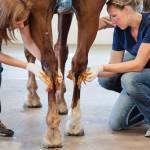Proceed with Caution: Intra-Articular Triamcinolone for Equine Joints

Is your veterinarian planning to use the steroid triamcinolone to treat joint disease in your metabolic or potentially metabolic horse? Experts urge horse owners to consider the systemic effects of this medication and potentially seek alternatives such as autologous protein solution (APS).*
Triamcinolone is a common medication injected intra-articularly, directly into joints, to treat osteoarthritis. Some of the medication gets absorbed systemically, however, and can have far-reaching effects. One potential side effect of intra-articular triamcinolone is laminitis.
“In healthy horses, injecting triamcinolone directly into a joint has little risk of inducing laminitis. In metabolic horses with high levels of insulin in the circulation, the risk for laminitis increases,” explained Kathleen Crandell, Ph.D., a Kentucky Equine Research nutritionist.
To better understand this risk, Page and colleagues from the University of Kentucky’s Maxwell H. Gluck Equine Research Center conducted a study examining the metabolic effects of a single injection of triamcinolone. All five horses used in this study were metabolically normal, free from both equine metabolic syndrome (EMS), insulin dysregulation, and pituitary pars intermedia dysfunction (PPID, equine Cushing’s disease). The metabolic effects of autologous protein solution (APS), another commonly used intra-articular treatment for osteoarthritis, were studied for comparison.
One fetlock joint of each horse was injected with either 9 mg triamcinolone or APS. Blood samples were collected immediately prior to the injection until 5.6 hours following injection. Samples were tested for insulin, glucose, cortisol, and thyroid hormone levels. Additionally, all horses were tested four times for PPID and insulin dysregulation (using the TRH and oral sugar tests, respectively) during the study.
In the triamcinolone group, cortisol decreased significantly, while both glucose and insulin increased. No change in the thyroid hormones were noted. Further, both tests for PPID and EMS were affected by the triamcinolone.
“Of specific concern was that the insulin concentrations in the horses exceeded 70 µIU/mL 48 hours after treating with triamcinolone, which far exceeds the 45 µIU/mL cutoff used to diagnose horses with insulin dysregulation. This was even more worrisome because the horses used in this study were metabolically normal,” Crandell said.
On the other hand, APS did not result in any significant differences in any of the tests.
The researchers concluded, “Triamcinolone acetonide exhibits significant metabolic side effects, while the commercially available autologous protein solution used here does not.”
These findings certainly raise more questions regarding the safety of intra-articular triamcinolone in metabolic horses, possibly suggesting that alternatives should be sought.
“Supporting optimal joint health should be undertaken prophylactically, prior to evidence of damage, by using preparations developed to counteract inflammation, reduce cartilage damage, and stimulate cartilage repair. Well-known joint support compounds include glucosamine, chondroitin, and sodium hyaluronate, which are found in high-quality supplements,” advised Crandell.
*Page, A.E., M. Johnson, J.L. Parker, O. Jacob, R. Poston, A.A. Adams, and E.N. Adam. 2024. The effects of intra-articular triamcinolone and autologous protein solution on metabolic parameters in horses. Animals (Basel) 14(15):2250.








